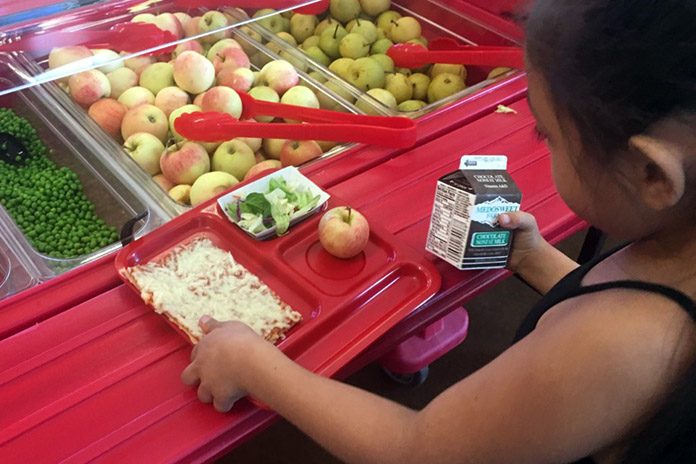
By Lynne Terry/Oregon Capital Chronicle
A quarter of a century ago, Oregon had one of the highest rates of food insecurity and hunger in the country. By 2019, the situation had greatly improved, and rates in the state dipped below the U.S. average.
Then the pandemic hit, and rates rose again. The latest data from the U.S. Census Bureau shows that about 11% of Oregon households are food insecure, struggle to have enough to eat and often have to choose between for paying rent, prescriptions or groceries. That means that 186,000 households, or 463,000 people, in Oregon have a problem securing enough food.
“We were making great progress in reducing food insecurity until the pandemic hit and progress reversed somewhat and is likely continuing this sort of unhealthy upward trend,” Mark Edwards, a professor at Oregon State University who studies food insecurity, said at a news conference last week.
The 2023 data is still being compiled, but he said the situation appears to be getting worse.
“I am hearing from our colleagues who provide emergency food that there remains extremely high and growing demand for emergency food assistance throughout the state,” Edwards said during the news conference.
With hunger growing, food advocates and a group of lawmakers on the Oregon Hunger Task Force called last week for the Legislature to enact in the upcoming session a number of measures to address hunger and the plight of low-income residents. The task force, which was created by the Legislature, is especially keen to get lawmakers to approve bills that would help students financially and help stem hunger among children.
That focus partly reflects the latest hunger data published by Edwards and a colleague last month. Their report shows that people of color, especially Native people and Hispanics, struggle more with hunger than white people, and that Asian Americans have the lowest rates of all. Among households, single mothers have the highest rates of food insecurity.
Renters also face hunger at a higher rate of hunger than those who own their homes, with about 20% of renters struggling with food insecurity compared with 5% of homeowners. And those without a high school diploma suffer much more from food insecurity compared with those with a bachelor’s degree or even a high school diploma.
There has been a huge improvement in the share of single mothers facing food insecurity in the past decade, and fewer renters scramble for enough food these days. But one category has failed to budge much: the urban-rural divide. About 20% of rural Oregonians have struggled to feed their families in recent years, about double the percentage of residents in urban areas. That surprised the researchers.
“The reasons for this divergence remain unclear, and the magnitude of this change in rural but not urban Oregon is surprising,” the report said. “If indeed these data accurately capture a disproportionate impact of the pandemic on rural Oregonians, this observation aligns with qualitative reports of the distinct challenges faced by rural social services during COVID, where volunteer, often older, staff at emergency food pantries were home-bound, or where schools struggled to deliver free/reduced price meals to children who would normally receive them in school may have lagged behind.”
Food advocates back several measures
Members of the task force, which was created by the Legislature and includes lawmakers from both parties, advocates and officials, hope the Legislature will approve $12.7 million to launch a free meal program in the summer for children in poor families.
They also want the Legislature to expand school meals for all. Officials at a news conference said the state has enough money to allow hundreds more schools to serve free meals regardless of the student’s ability to pay starting next fall. But the rules need to change to align with federal requirements.
And they’re asking lawmakers to approve $6 million through House Bill 4162, a student emergency needs package. Nick Keough, legislative director for the Oregon Student Association, said students are struggling to pay for textbooks, housing, transportation, health care and their living expenses.
“Financial aid programs and scholarships designed for low-income students fail to cover the bulk of their needs and do not reach the costs associated with attendance, such as food, housing, textbooks, transportation, etc.,” Keough said. “We are seeing a pretty dire situation, especially coming out of the pandemic.”
Other requests – from Partners for a Hunger-Free Oregon, the Children’s Institute and the Oregon Food Bank – include a $600,000 allocation for providers participating in the federal Child and Adult Care Food Program and $10 million for the Oregon Food Bank.
The Legislature regularly allocates money to the food bank, which serves 21 regional food banks that work with more than 1,400 free food markets, pantries, meal sites and delivery programs. And the federal government supports the Child and Adult Care Food Program by paying participating child care centers, day care homes and adult day care centers to provide nourishing meals. Regional nonprofits participate by conducting three site visits a year, but that’s become untenable for many, especially in rural areas, according to officials from Partners for a Hunger-Free Oregon. They said a one-time infusion of cash would stabilize the program.
That program and more just need a bit more help to keep going, said Angelita Morillo, policy advocate for Partners for a Hunger-Free Oregon.
“There are a lot of great structures that already exist in Oregon to address hunger-related issues,” she said. “A lot of them just don’t have the appropriate funding.”
This story first appeared in the Oregon Capital Chronicle.








